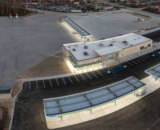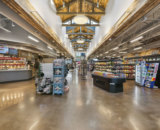E-commerce is a $300 billion industry disrupting the face of retail and continues to grow within the United States. During NATSO Connect, Ken Cassar, a principal analyst at Slice Intelligence, told attendees that online sales are impacting their businesses, but there are ways truckstop and travel plaza operators can tap into the trend to offer convenience to their customers.
Staying current on online shopping trends is crucial for operators, Cassar said. “Be aware of what these disruptive players are doing in your space. You will be amazed at how far afield they are willing to move over the course of time,” he explained.
Today e-commerce represents about 9 percent of total U.S. consumer spending, and disruption has become the new normal, particularly because consumers are willing to adopt new technologies faster than ever. “The telephone took 75 years to reach 80 percent of Americans,” Cassar said. “When we fast forward we see the cell phone took 15 years to reach mass penetration.”
What’s more, consumers are discarding companies and brands like never before, and retailers are working hard to remain relevant, which often means they’re moving into spaces they’ve never occupied. “Companies are starting to not pay attention to the swim lanes that they used to,” he said, adding that Kohls, a clothing retailer, is looking at adding groceries to drive traffic.
To capture new opportunities, truckstops and travel plazas must follow suit, expanding into offerings they haven’t traditionally carried, said Darren Schulte, vice president of membership for NATSO.
Operators can also look for trends outside of the industry to find new opportunities. Ridesharing with companies such as Uber and Lyft has increased, with Americans taking 1.4 billion rides in 2017. Cassar said there could be an opportunity for truckstops and travel plazas to tap into Uber and Lyft drivers as fleet customers.
In terms of what’s in store for the bricks-and-mortar store, Cassar told NATSO Connect attendees an omni-channel experience that allows people to buy online and pick up in person will continue to gain relevance. In some locations, Walmart, for example, offers online grocery orders that can be picked up curbside and also offers the opportunity to fuel up or grab a cup of coffee at the location. “My concern is they could use gas as a loss leader to drive online pick up operations,” he said.
In online retail, Amazon remains the biggest online player, account for about 41 percent of U.S. e-commerce sales. Walmart has increased its e-commerce efforts, but Amazon is still 10 times the size of Walmart.com, Cassar said.
The use of Amazon lockers, which allow customers to have product delivered to a locker location versus their doorstep, has increased, and they could be a good solution for truckstops looking to appeal to truck drivers who are shopping online while on the road. However, Amazon hasn’t been engaged with truckstops that have inquired about adding the lockers. “There may be opportunities to create your own solution,” Cassar said.
Operators should also notice the growth in food delivery options, such as Uber Eats and Grub Hub that take food from various restaurants directly to consumers. Cassar said Uber Eats accounted for a quarter of all growth in the food service industry last year. Plus, a number of food service operators are embracing mobile technologies that allow customers to order ahead and pay via the app. At Starbucks, 30 percent of orders are now placed with the app.
While growth from e-commerce giants and tech provides can seem daunting, Cassar told attendees they can learn from them to drive creative solutions at their locations. “They’ve built environments where they encourage people to innovate and try new things,” he said, adding that if an initiative fails, the person behind it is lauded lauded for trying something new and then making the decision not to continue with it if it isn’t working.
Photo credit: Brittany Palmer/NATSO
Subscribe to Updates
NATSO provides a breadth of information created to strengthen travel plazas’ ability to meet the needs of the travelling public in an age of disruption. This includes knowledge filled blog posts, articles and publications. If you would like to receive a digest of blog post and articles directly in your inbox, please provide your name, email and the frequency of the updates you want to receive the email digest.

